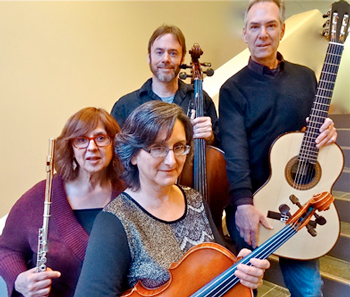by James Flood

The group’s program included a couple of little-known yet delightful works which may well be entering a decade of greater popularity. The Happy Days Lodge provides an appropriately simple, rustic atmosphere. While it has a manicured lawn, it is located alongside a Cuyahoga Valley National Park hiking trail, with hikers walking past as the concertgoers filed in.
The CVCP opened with four arrangements for flute and cello of Bach keyboard pieces and a solo vocal piece, played by Berkner and Richardson. While the opening of the set, Invention 8, was somewhat shaky, the two performers settled into the slower pieces, “Air” from French Suite No. 2 and the aria “So oft ich meine tobacksfieife” from the Notebook for Anna Magdalena Bach, playing both pieces beautifully. The “Prelude in G Major” from the Well-Tempered Clavier Bk. 1 was performed tightly at a brisk tempo that scarcely allowed Berkner a chance to breathe.
The now obscure 20th century Viennese composer Ferdinand Rebay was represented by his Quartet in A Minor. Rebay wrote in a decidedly 19th-century style while the rest of the classical musical world of the 1930s and ‘40s was experimenting with atonality and extreme chromaticism. While he did receive numerous prizes, he was ultimately rejected in his day and died poor and forgotten. His work may well be vindicated by the test of time, as it is currently enjoying a resurgence of programming.
The quartet is a sizable four-movement work. Although the first movement is marked Allegro, it frequently changes tempos, betraying a variety of moods — at times stern and aggressive, at other times slow, lyrical and beautifully pastoral. Its sections transition abruptly from one to another in a manner reminiscent of Brahms.
The guitar can easily be overpowered in ensembles, but due to Rebay’s writing, Stephen Aron’s strong playing, and Aron’s guitar, which projected clearly with a particularly crisp and lovely tone, it fit in absolutely beautifully. While the cello had its moments of activity, Rebay frequently had Richardson playing sustained single bass notes and double stops. This often gave the Allegro a grand, pastoral feeling, making the group sometimes sounded larger than it was. The third movement Scherzo and Trio was notable for its heavy motivic development, harkening back to the still earlier time period of Beethoven.
Brazillian composer Heitor Villa-Lobos’s Jet Whistle is a cello-flute duet written in an attention-grabbing way that only Villa-Lobos can pull off. In the opening of the first movement, the cello played a passionate melody while the flute repeated simple quarter notes of a single slurred pitch over and over again. This could conceivably become annoying, but Villa-Lobos gave it a sense of mystery. In the contrasting section, the flute breaks into rich and rhythmic melodies. In the second movement Adagio, the cello plays double stops with constantly falling lines as the flute solos above it. The ever-falling harmonies create dark, foreboding music that could easily find its way into a Hitchcock film.
In the closing movement, Vivo, a no-nonsense driving pattern of dissonant melodic intervals in the cello sounds more like Metallica than a Brazilian classical composer writing before the advent of rock music. Berkner deftly played the fast, improvisatory-sounding, and aggressive solo above the menacing cello line, sounding like a screaming electric guitar solo. The effect was powerful.
CVCP closed with two Caribbean dances from Cuban-born American composer Ricardo Iznaola’s Danzas de la Abuela, a guitar, flute and cello trio. Both the “Habanera” and the “Merengue” employed an almost unremitting rhythmic pattern which got the audience’s toes tapping. The “Merengue” was a fitting conclusion for the performance, with the trio breaking into staccatos and pizzicatos toward the end to exciting effect.
Published on ClevelandClassical.com July 28, 2015.
Click here for a printable copy of this article



